Graduate Aptitude Test in Engineering 2017
Question Paper Name: Engineering Sciences 12th Feb 2017
Subject Name: Engineering Sciences
Duration : 180
Total Marks: 100
Engineering Mathematics (XE-A) (Compulsory)
1. If  for some α ≥ 1, then the value of α is ______.
for some α ≥ 1, then the value of α is ______.
Ans: (2.98 to 3.02)
2. Three fair dice are rolled simultaneously. The probability of getting a sum of 5 is
(A) ![]()
(B) ![]()
(C) ![]()
(D) ![]()
Ans: (D)
3. Suppose α, β, γ and δ are constants such that
p(x) = δ + γ(x + 1) + βx(x + 1) + αx(x + 1) (x – 1)
is the interpolating polynomial for the data (−1, −3), (0, 1), (1, −1), and (2, −3). Then the value of γ – β is _______.
Ans: (6.98 to 7.02)
4. Consider the ordinary differential equation
yʹʹ + αyʹ + βy = 0,
where α and β are constants. If y(x) = xex is a solution of the above equation, then the value of β – α is ________.
Ans: (2.98 to 3.02)
5. Consider the system of linear equations
2x + x3 = 0
−2x1 – x3 = 0
−x1 + x2 = 1.
The above system has
(A) a unique solution
(B) infinite number of solutions
(C) no solution
(D) only two distinct solutions
Ans: (C)
6. Let C be a simple smooth closed curve enclosing the region R in the xy-plane. Let C be oriented counterclockwise. If the value of the integral  is 16, then the area of R is ________.
is 16, then the area of R is ________.
Ans: (7.98 to 8.02)
7. Consider the ordinary differential equation
x2yʹʹ + xyʹ – y = x, x > 0.
In terms of arbitrary constants c1 and c2, the general solution of the above equation is
(A) y(x) = c1x + c2x−1 + x3
(B) ![]()
(C) ![]()
(D) y(x) = c1x + c2 + x−1
Ans: (C)
8. Let f : ℝ → ℝ and g : ℝ → ℝ be defined by
 and
and 
where ℝ denotes the set of real numbers. Then, at x = 0,
(A) f is differentiable but g is NOT differentiable
(B) f is NOT differentiable but g is differentiable
(C) both f and g are differentiable
(D) neither f nor g is differentiable
Ans: (A)
9. If u(x, t) = g(t) sin x is the solution of the wave equation utt = uxx, t > 0, 0 < x < π, with the initial conditions u(x, 0) = 2 sin x, ut(x, 0) = 0, 0 ≤ x ≤ π, and the boundary conditions u(0, t), = u(π, t) = 0, t ≥ 0, then the value of g(π/3) is _______.
Ans: (0.98 to 1.02)
10. Let  where t is a real variable and i = √−1. The value of I is ______.
where t is a real variable and i = √−1. The value of I is ______.
Ans: (-0.02 to 0.02)
11. Let ak = 2−kk4 sin k and ![]() for k = 1, 2, …. Then
for k = 1, 2, …. Then
(A) ![]() converges but
converges but ![]() does NOT converge
does NOT converge
(B) ![]() does NOT converge but
does NOT converge but ![]() converges
converges
(C) both ![]() and
and ![]() converge
converge
(D) neither ![]() nor
nor ![]() converges
converges
Ans: (C)
Fluid Mechanics (XE-B)
12. In a given flow field, the velocity vector in Cartesian coordinate system is given as:

What is the volume dilation rate of the fluid at a point where x = 1, y = 2 and z = 3?
(A) 6
(B) 5
(C) 10
(D) 0
Ans: (B)
13. A steady, incompressible, two-dimensional velocity field in Cartesian coordinate system is represented by the following expression.

The coordinate of the point (x, y) in the flow filed having “zero” velocity is,
(A) (1.75, −3)
(B) (−1.75, 3)
(C) (1.75, 3)
(D) (−1.75, −3)
Ans: (B)
14. During an experiment, the position of a fluid particle is monitored by an instrument over a time period of 10 s. The trace of the particle given by the following figure represents a

(A) streamline
(B) streakline
(C) pathline
(D) timeline
Ans: (C)
15. In a Cartesian two-dimensional coordinate system, u and v represent the velocities in x and y directions, respectively. For a certain flow, the velocity filed is represented by the following expression:

where, the coefficients a, b, c and d are constants. For an incompressible flow, which one of the following relations is TRUE?
(A) a + d = 0
(B) a + c = 0
(C) b + d = 0
(D) b + c = 0
Ans: (A)
16. Which one of the following figures represents potential flow past a circular cylinder with clockwise rotation of the cylinder?
(A) 
(B) 
(C) 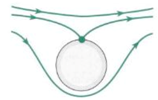
(D) 
Ans: (D)
17. The stream function (Ψ) of a velocity field at any location(x, y) is given as, Ψ = xy2 – 2x2y2. What is the rate of rotation of a fluid element located at (x = 2, y = 2)?
(A) 8
(B) 10
(C) 12
(D) 14
Ans: (D)
18. The nature of velocity profile within the laminar viscous sublayer in a turbulent pipe flow is
(A) linear
(B) parabolic
(C) logarithmic
(D) exponential
Ans: (A)
19. In a 5 m deep vertical cylindrical tank, water is filled up to a level of 3 m from the bottom and the remaining space is filled with oil of specific gravity 0.88. Assume density of water as 1000 kg/m3 and acceleration due to gravity to be 10 m/s2. The gauge pressure (in kN/m2, rounded off to the first decimal place) at a depth of 2.5 m from the top of the tank will be______
Ans: (22.6)
20. In a two-dimensional potential flow, a point source is located at the origin (x = 0, y = 0) as shown in the figure. The strength of the point source is 2 cm2/s. A uniform flow with velocity 1 cm/s is approaching towards the point source at an angle of 30° from the horizontal axis. What is the distance (cm) of the stagnation point in the flow field from the point source?
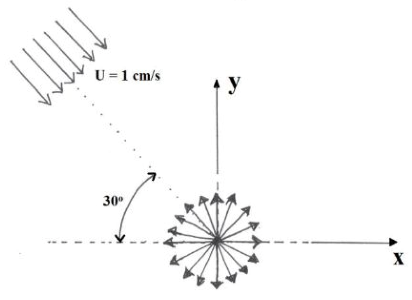
(A) ![]()
(B) ![]()
(C) ![]()
(D) ![]()
Ans: (A)
21. Two infinite parallel horizontal plates are separated by a small gap(d = 20 mm) as shown in figure. The bottom plate is fixed and the gap between the plates is filled with oil having density of 890 kg/m3 and kinematic viscosity of 0.00033 m2/s. A shear flow is induced by moving the upper plate with a velocity of 5 m/s. Assume, linear velocity profile between the plates and the oil to be Newtonian fluid. The shear stress(N/m2) at the upper plate is _______
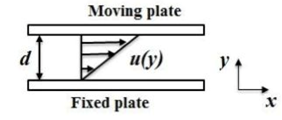
Ans: (72.5 to 75)
22. A spherical balloon of diameter 15 m is supposed to lift a load of 3000 N. The lifting of load is achieved by heating the air inside the balloon. Assume, air to be an ideal and atmospheric pressure either outside or inside the balloon. The value of acceleration due to gravity is 9.81 m/s2 and the values of temperature and density of atmospheric air are 15℃ and 1.2 kg/m3, respectively. In order to lift the specified load, the air inside the balloon should be heated to a temperature (℃) of _______
Ans: (62 to 66)
23. The velocity field in Cartesian coordinate system for a two-dimensional steady flow is given as :

where, V0 and L are constants. Which one of the following expressions represents the acceleration field ![]() for this flow?
for this flow?
(A) ![]()
(B) 
(C) 
(D) 
Ans: (D)
24. A cylindrical tank of 0.8 m diameter is completely filled with water and its top surface is open to atmosphere as shown in the figure. Water is being discharged to the atmosphere from a circular hole of 15 mm diameter located at the bottom of the tank. The value of acceleration due to gravity is 9.81 m/s2. How much time (in seconds) would be required for water level to drop from a height of 1 m to 0.5m?
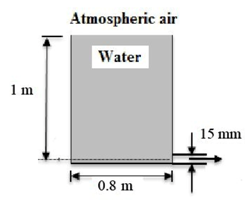
(A) 188
(B) 266
(C) 376
(D) 642
Ans: (C)
25. Consider steady laminar flow of a incompressible Newtonian fluid between two infinite parallel plates, separated by a distance of 1 m, as shown in the figure. The bottom plate is stationary but the top one is moving in positive x-direction with a velocity of 3 m/s. The fluid pressure gradient in the flow direction is: ![]() If the viscosity of the fluid is 1 kg m−1 s−1 then the distance of the point of maximum velocity (in meters, rounded off to the second decimal place) from the bottom plate would be _______
If the viscosity of the fluid is 1 kg m−1 s−1 then the distance of the point of maximum velocity (in meters, rounded off to the second decimal place) from the bottom plate would be _______

Ans: (0.66 to 0.67)
26. An inviscid incompressible fluid of density 1000 kg/m3 is flowing in a horizontal pipe of tapered cross-section with a flow rate of 4000 cm3/s. The area of cross-section at two different locations ‘A’ and ‘B’ are 10 cm2 and 20 cm2, respectively. The velocity of fluid at the location ‘A’ is 4 m/s and pressure is 5 N/m2. The pressure (N/m2) at location ‘B’ would be ______
Ans: (6005 to 6005)
27. A viscous, incompressible and Newtonian fluid flowing through the main branch of a circular pipe bifurcates into two daughter branches whose radii are 4 cm and 2 cm, respectively. The flow in both the daughter branches are laminar and fully developed. If the pressure gradients in both the daughter branches are same, then fraction of total volumetric flow rate (rounded off to the second decimal place) coming out from the branch with 4 cm diameter is _______
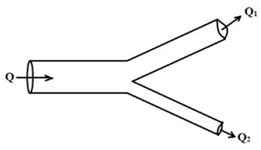
Ans: (0.05 to 0.06)
28. The volumetric flow rate (Q) of a triangular notch is a function of the upstream liquid surface elevation (H) measured from the bottom of the notch, acceleration due to gravity (g), notch angle (ϕ) and the approach velocity (V). Which one of the following is the correct expression for Q?
(A) ![]()
(B) ![]()
(C) ![]()
(D) ![]()
Ans: (D)
29. Model tests are to be carried out to study the flow through a large prototype value of 0.6 m diameter at a flow rate of 10 m3/s. The same working fluid is used for both the model and the prototype. A complete geometric similarity is maintained between the model and the prototype. If the valve diameter of the model is 80 mm, its required flow rate (in m3/s, rounded off to the first decimal place) would be ________
Ans: (1.3 to 1.4)
30. Water is flowing at a rate of 0.5 m3/s in a horizontal pipeline of inside diameter 0.5 m. The density and kinemat4ic viscosity of water is 1000 kg/m3 and 10−6 m2/s, respectively. Assume Darcy-Weisbach friction factor value to be 0.0093 and acceleration due to gravity as 9.81 m/s2. To maintain constant flow rate, the required power per unit length of the pipeline (in W/m, rounded off to the first decimal place) would be ______
Ans: (28.9 to 31.4)
31. Air flows over a smooth flat plate at a velocity of 4.39 m/s. The density of air is 1.031 kg/m3 and the kinematic viscosity is 1.34 × 10−5 m2/s. The plate length is 12.2 m in the direction of the flow. The boundary layer thickness (δ) is given as ![]() where X is the distance from the leading edge and ReX is the Reynlods number. The boundary layer thickness (in meters, rounded off to the second decimal place) at 12.2 m from the leading edge will be ______
where X is the distance from the leading edge and ReX is the Reynlods number. The boundary layer thickness (in meters, rounded off to the second decimal place) at 12.2 m from the leading edge will be ______
Ans: (0.21 to 0.22)
32. A venturimeter of diameter 0.2 m at the entrance and 0.1 m at the throat is inclined upwards. The vertical elevation difference between the entrance and the throat is 0.5 m. The density of water is 1000 kg/m3 and the coefficient of velocity is 0.97. The differential U-tube manometer connected to the entrance and throat shows a pressure difference of 30 kN/m2. Assume acceleration due to gravity as 9.81 m/s2. The velocity of the water (in m/s, rounded off to the first decimal place) at the throat would be ______
Ans: (7.0 to 7.2)
33. A spherical bubble of radius r is rising upward with a constant velocity U, in quiescent water of dynamic viscosity μ. The density of air and water are denoted by ρa and ρw, respectively, and g is acceleration due to gravity. The bubble motion is such that, the Reynolds number, Re <<1. The density of air can be neglected in comparison to the water density (ρa << pw). Which one of the following expressions is TRUE for the density of water?
(A) ![]()
(B) ![]()
(C) ![]()
(D) ![]()
Ans: (B)
Material Science (XE-C)
34. Which of the following is a Frenkel defect?
(A) One Cl vacancy and one Na vacancy in NaCl
(B) One Zn vacancy and one Zn interstitial in ZnO
(C) K at the Na site in NaCl
(D) None of the above
Ans: (B)
35. Which processing technique is best suited for manufacturing decorative PVC floor tiles?
(A) Blow molding
(B) Filament winding
(C) Rotational molding
(D) Calendering
Ans: (D)
36. During deformation of a semi-crystalline polymer, with spherulitic morphology, stressed in tension, what happens to the amorphous and the crystalline regions at the later stages?
(A) Amorphous regions remain intact and only crystallites experience bending and stretching of chains
(B) Only amorphous regions elongate in the stress direction and crystallites remain intact
(C) Amorphous regions elongate in the stress direction and crystallites experience bending and stretching of chains
(D) None of the above
Ans: (C)
37. Which of the following statement(s) is/are true regarding the structure-property correlation in polymers?
(i) Polymer that are less coiled are more crystalline than those that are more coiled
(ii) Branched polymers are more crystalline than the linear ones
(iii) Polymers with inter-chain interactions have higher glass transition than those without inter-chain interactions
(iv) Polymers with inter-chain interactions are more crystalline than those without interchain interactions
(A) (i) and (ii)
(B) (i) and (iii)
(C) (ii) and (iv)
(D) (ii) and (iii)
Ans: (B)
38. The contrast obtained in scanning electron microscope using back scattered electrons depends on
(A) Atomic number of the specimen material
(B) Accelerating voltage of the microscope
(C) Working distance in the microscope
(D) Type of the electron emitter in the microscope
Ans: (A)
39. Ceramic material fail at stresses much lower than their theoretical strength due to
(A) Presence of dislocations
(B) High elastic modulus
(C) Presence of voids
(D) Anisotropy in crystal structure
Ans: (C)
40. The Miller indices of the first three Bragg peaks in the X-ray diffraction pattern obtained from a polycrystalline iron sample at room temperature are
(A) (111), (200), (220)
(B) (100), (110), (111)
(C) (1000), (110), (200)
(D) (110), (200), (220)
Ans: (D)
41. The number of close packed planes in the lattice of an FCC metal is
(A) 2
(B) 4
(C) 6
(D) 12
Ans: (B)
42. Which of the following treatment(s) can increase the electrical conductivity of silicon
(i) Heating
(ii) Doping with arsenic
(iii) Doping with aluminium
(iv) Exposure to light
(A) Only (i)
(B) Only (i) and (ii)
(C) Only (i), (ii) and (iv)
(D) All (i), (ii), (iii) and (iv)
Ans: (D)
43. The unit cell volume of polyethylene (PE) is 0.0933 nm3. Assuming two ethylene repeat units are contained within each unit cell, the density of a totally crystalline PE will be …….g/cm3 (Take the atomic weights for carbon and hydrogen as 12.01 g/mol and 1.008 g/mol, respectively and the Avogadro’s number as 6.023 × 1023 repeat units/mol)
Ans: (0.990 to 1.010)
44. A continuous, aligned carbon fibre (CF) reinforced polymer composite with 30 vol% of CF and rest resin was designed for a specific application. The modulus of elasticity of CF is 170 GPa and that of the resin is 3.0 GPa. The modulus of elasticity for this composite in the direction of fibre alignment is ……GPa.
Ans: (53.0 to 53.2)
45. Match the composites in Column I with the most suitable application in Column II
Column I
(P) Exfoliated silicates filled butyl rubber
(Q) Fiber reinforced aluminium alloy
(R) Silicon carbide whiskers reinforced alumina
(S) Carbon particles reinforced plastic composites
Column II
(1) Automobile pistons
(2) Contact lenses
(3) Ski boards
(4) Tennis balls
(5) Cutting tool inserts for machining
(A) P-4; Q-1; R-5; S-3
(B) P-2; Q-3; R-4; S-5
(C) P-3; Q-5; R-5; S-3
(D) P-2; Q-1; R-3; S-5
Ans: (A)
46. Match the processes in Column I with products in Column II
Column I Column II
(P) Slip casting (1) Metal powders
(Q) Zone refining (2) Thin films
(R) Sputtering (3) Ceramic part
(S) Atomization (4) Single crystal
(5) Metal sheets
(A) P-3; Q-4; R-2; S-1
(B) P-2; Q-1; R-2; S-1
(C) P-3; Q-4; R-5; S-1
(D) P-3; Q-4; R-1; S-5
Ans: (A)
47. The value of diffusivity (D) for the diffusion of carbon (C) in γ-iron at 727℃ is …….×10−3 m2/s (Given Do = 2 × 10−5 m2/s; activation energy, Q = 142 kJ/mol; R = 8.314 J/mol.K)
Ans: (7.5 to 7.7)
48. Refer to the figure below:
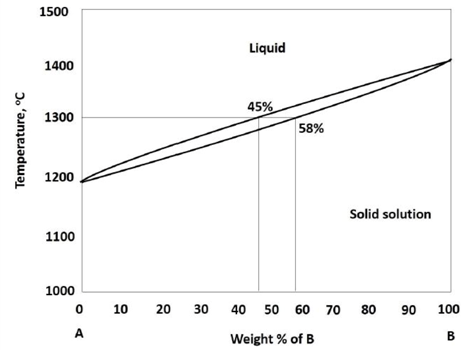
If the alloy contains 47 wt. % of A and 53 wt. % of B at 1300℃, the wt. % of liquid present in the alloy at this temperature will be ……
Ans: (37.5 to 38.5)
49. Which of the following statement(s) is/are true
(i) All piezoelectric material are necessarily ferroelectric
(ii) All ferroelectric materials are necessarily piezoelectric
(iii) All pyroelectric materials are necessarily piezoelectric
(iv) All pyroelectric materials are necessarily ferroelectric
(A) (i) and (ii)
(B) (ii) and (iii)
(C) (i) and (iv)
(D) (ii) and (iv)
Ans: (B)
50. If the energy of formation of vacancies in pure copper is 0.9 eV, the fraction of vacancies in pure copper at 27℃ will be …..×10−6 (Boltzmann’s constant is 8.62 × 10−5 eV/K)
Ans: (7.50 to 7.80)
51. A ceramic material with a critical flaw size of 30 μm has fracture stress of 300 MPa For the same material the fracture stress for a critical flaw size of 90 μm will be ……..MPa.
Ans: (172 to 174)
52. An inorganic material that is transparent under solar light appears coloured when doped with transition metal ions. The possible reason(s) for the colour is/are
(i) The electronic energy levels of the host material changes significantly by doping
(ii) The doped element selectively absorbs certain wavelength of light other than the perceived colour
(iii) The doped element emits radiation of specific wavelength
Which of the above statement(s) is/are true?
(A) Only (i)
(B) Both (i) and (ii)
(C) Both (i) and (iii)
(D) Both (ii) and (iii)
Ans: (D)
53. Copper in an FCC metal with lattice parameter of 3.62 Å. Hall effect measurement shows electron mobility to be 3.2 × 10−3 m2V−1s−1. Electrical resistivity of copper is 1.7 × 10−8 Ω The average number of free electrons per atom in copper is ……..(Charge of an electron : 1.6 × 10−19 C)
Ans: (1.35 to 1.37)
54. In an ionic solid the cation and the anion have ionic radii as 0.8 Å and 1.6 Å respectively. The maximum coordination number of the cation in the structure will be
(A) 3
(B) 4
(C) 6
(D) 8
Ans: (C)
55. Which of the following statement(s) is/are true regarding susceptibility of a material
(i) Magnetic susceptibility is positive for a diamagnetic material
(ii) Magnetic susceptibility is negative for a diamagnetic material
(iii) Magnetic susceptibility is negative for an antiferromagnetic material
(iv) Magnetic susceptibility is positive for a paramagnetic material
(A) (ii) and (iv)
(B) (i) and (iii)
(C) (ii) and (iii)
(D) (i) and (iv)
Ans: (A)
Solid Mechanics (XE-D)
56. In the truss shown, a mass = 10 kg is hung from the node J. .The magnitude of net force (in Newtons) transferred by the truss EFGHIJ onto the trus JKLMNO at the node J is _______.
Assume acceleration due to gravity, g = 10 m/s2
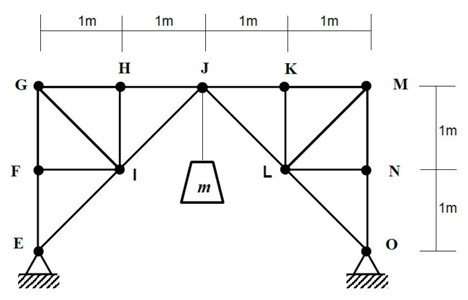
Ans: (69 to 73)
57. A ball moves along a planar frictionless slot as shown. Which one of the paths shown closely matches the path taken by the ball after it exits the slot at E?
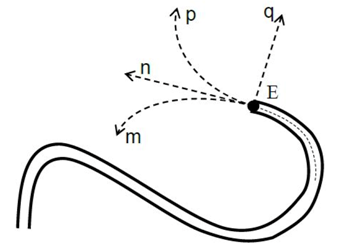
(A) path m
(B) path n
(C) path p
(D) path q
Ans: (B)
58. A rod EF moving in a plane has velocity VE at E and VF at F that are parallel to each other. Which of the following CANNOT be true?

(A) Both VE and VF are perpendicular to EF.
(B) Magnitude of VE is equal to the magnitude of VF and the angular velocity of EF is zero.
(C) The velocity VE is not perpendicular to EF and the angular velocity of EF is nonzero.
(D) Magnitude of VE is not equal to the magnitude of VF and the angular velocity of EF is nonzero.
Ans: (C)
59. The beam shown below carries two external moments. A counterclockwise moment of magnitude 2M acts at point B and a clockwise moment of magnitude M acts at the free end, C. The beam is fixed at A. The shear force at a section close to the fixed end is equal to

(A) ![]()
(B) ![]()
(C) ![]()
(D) 
Ans: (C)
60. Two pendulum are shown below. Pendulum-A carries a bob of mass m, hung using a hinged massless rigid rod of length L whereas Pendulum-B carries a bob of mass 4m and length L/4. The ratio of the natural frequencies of Pendulum-A and Pendulum-B is given by
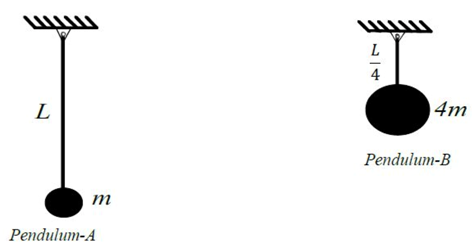
(A) 1 : 2
(B) 1 : 1
(C) √2 : 1
(D) 2 : 1
Ans: (A)
61. A closed thin-walled cylindrical steel pressure vessel of wall thickness t = 1mm is subjected to internal pressure. The maximum value of pressure p(in kPa) that the wall can withstand based on the maximum shear stress failure theory is given by
(Yield strength of steel is 200MPa and mean radius of the cylinder r = 1m).
(A) 100
(B) 200
(C) 300
(D) 400
Ans: (B)
62. The state of stress at a point in a body is represented using components of stresses along X and Y directions as shown. Which one of the following represents the state of stress along X’ and Y’ axes? (X’ – axis is at 45° clockwise with respect to X-axis)
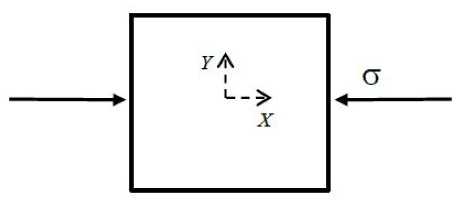
(A) 
(B)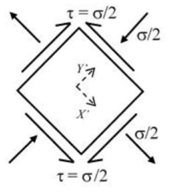
(C) 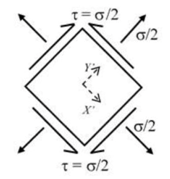
(D) 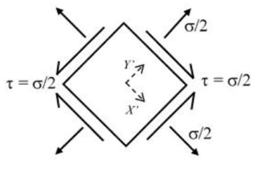
Ans: (A)
63. An aluminum specimen with an initial gauge diameter d0 = 10mm and a gauge length l0 = 100mm is subjected to tension test. A tensile force P = 50kN is applied at the ends of the specimen as shown resulting in an elongation of 1mm in the gauge length. The Poisson’s ratio (v) of the specimen is _____.
Shear modulus of the material G = 25GPa. Consider engineering stress-strain conditions.

Ans: (0.26 to 0.28)
64. A rectangular sheet ABCD of dimensions a and b along X and Y directions, respectively, is stretched to a rectangle AB’C’D, as shown. The maximum principal strain (ε1) and minimum principal strain (ε2) due to the stretch are given by
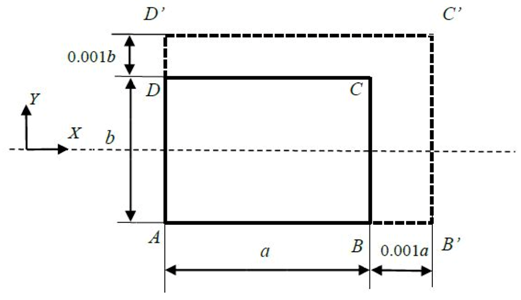
(A) ε1 = 0.001 and ε2 = 0.001
(B) ε1 = −0.001 and ε2 = 0.001
(C) ε1 = 0.001 and ε2 = −0.001
(D) ε1 = −0.001 and ε2 = −0.001
Ans: (A)
65. A solid bar of uniform square cross-section of side b and length L is rigidly fixed to the supports at the two ends. When the temperature in the rod is increased uniformly by Tc, the bar undergoes elastic buckling. Assume Young’s modulus E and coefficient of thermal expansion α to be independent of temperature. The coefficient of thermal expansion α is given by
(A) 
(B) ![]()
(C) ![]()
(D) ![]()
Ans: (D)
66. Two rigid blocks, of masses 10 kg and 15 kg, are arranged one on top of the other and placed on a horizontal rough surface as shown. The blocks are connected to each other through an inextensible cable passing over a frictionless pulley. The coefficients of static friction between the blocks and also between the bottom block and the surface are all equal to 0.3. The force P(in Newtons) needed to set the blocks in motion towards right is ______
(Assume acceleration due to gravity g = 10m/s2)

Ans: (134 to 136)
67. A truss system EFGH shown below is built using members EF, GH and FH of the same cross-sectional area 10 mm2 and member FG of cross-sectional area (20 mm2). The total strain energy stored (in Nm) in the system due to a force P = 1kN acting at F is _______.
Assume elastic deformations and members are made of steel with elastic modulus of 200GPa.
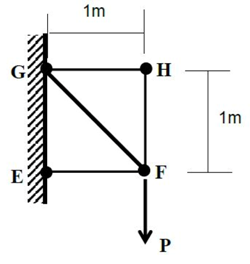
Ans: (0.55 to 0.65)
68. A rigid frame grips on to a steel wall as shown using a powerful magnet at the top support G and with a roller support at E. EF is horizontal. A man stands on the platform attached to the frame 1m away from the wall as shown. Assume the frame and magnet assembly to be of negligible weight and the mass of the man to be 80kg. The magnitude of the reaction (in Newtons) exerted by the frame onto the steel wall due to the weight of the man is ______.
The magnetic force of attraction of the magnet at no load condition is 1kN. Magnet can be assumed to be small enough that it offers negligible moment resistance. Assume accelerations due to gravity. g = 10 m/s2

Ans: (1785 to 1792)
69. A manually operated band brake has a control lever EFG as shown has a coefficient of kinetic friction equal to 0.2. The cylinder initially rotates clockwise at a constant frequency of 10revolutions per second. A force P = 300 N is applied at G. The pin support at O is frictionless. The radius of the cylinder is r = 0.15m and the radius of gyration is 0.1m. The mass of the cylinder is 50 kg. Assume acceleration due to gravity g = 10 m/s2. The time required (in second) to reduce the rotational frequency to 5 revolutions per second is ______.
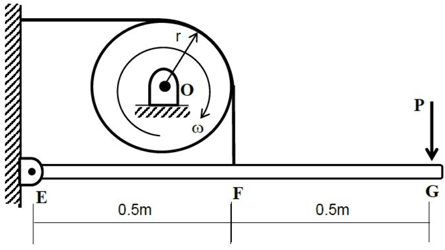
Ans: (0.45 to 0.50)
70. In a pin-connected mechanism shown, load P applied at F is 50N. Neglect the weight of the links and assume k = 1kN/m for the spring. The bars EH and FG are pinned at O at their centre such that the lengths of EO, GO, HO and FO are all to ℓ = 0.2 m. The spring between G and H is unstretched when θ = 45°.
The angle θ(in degrees) under equilibrium is ______
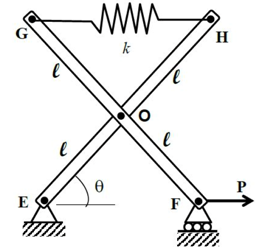
Ans: (32 to 35)
71. The frame shown below carries a vertical load P = 10kN at its free end D. The frame is fixed at A and has a roller support at B. Magnitude of the reaction force at B(in kN) is ________
Assume that the effect of the axial force on bending is negligible.

Ans: (10 to 10)
72. Consider the system shown below. Mass M is fixed to the rod AC at a distance x from the hinge point at B. Two springs of stiffness 3K and K are attached at the rod at points A and C, respectively. The natural frequency of angular oscillation of the system about B is 20 rad/s. Assume the rod to be rigid and massless. Magnitude of x(in metres) is _______.
(M = 30 kg, and K = 1kN/m).
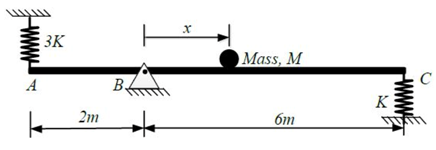
Ans: (02 to 02)
73. The simply supported beam shown below is subjected to a clockwise moment M at point A and two counterclockwise moments 2M and M at points B and C, respectively. Which one of the following is the correct bending moment diagram (tensile at bottom is positive moment) for the beam?

(A) 
(B) 
(C) 
(D) 
Ans: (A)
74. The structure shown below is of rectangular cross section and carries a load of 10kN at its free end E. Maximum bending stress (in MPa) developed in the beam due to the external load is ______.
The depth of the beam is 300 mm and the width is 150mm.
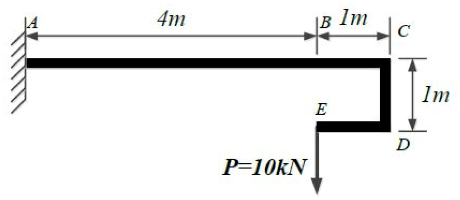
Ans: (17 to 18)
75. Two circular rods shown below carry the same axial load P. The rod-A has uniform cross-section and the Rod-B has non-uniform cross-section as shown. The ratio of elongation of Rod-A to Rod-B is given by
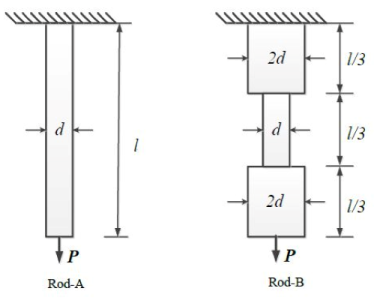
(A) 1 : 1
(B) 1 : 2
(C) 2 : 1
(D) 3 : 1
Ans: (C)
76. A composite shaft is made of a steel tube with an inner brass core perfectly bonded together as shown. The shaft is fixed at one end and subjected to be torque of 2T at the other end. Shear modulus of steel is G and that of brass is G/2. The outer radius of the steel tube is R =2r and radius of the inner brass core is r. The magnitude of shear stress at the interface (point X) and in the steel tube is closest to

(A) ![]()
(B) ![]()
(C) ![]()
(D) ![]()
Ans: (B)
77. A massless rod of rectangular cross-section is subjected to a force P at origin O as shown. The expression for the stress σzz at point Q is given by

(A) ![]()
(B) ![]()
(C) ![]()
(D) ![]()
Ans: (B)
Thermodynamics (XE-E)
78. Given dϕ = f(T)dT + (T/V)dV and dΨ = Tdp + (T/p2)dV, then
(A) both ϕ and Ψ are properties
(B) neither ϕ nor Ψ is a property
(C) ϕ is a property but Ψ is not a property
(D) Ψ is a property but ϕ is not a property
Ans: (B)
79. A paddle wheel is installed in a rigid insulated tank containing 10 kg air (Cv = 0.718 kJ/kg.K). A torque of 100 N.m is applied on the paddle wheel to rotate it at 60 revolutions per minute for 2 minutes. At the end of the process, the increase in temperature of air in ℃ is
(A) 0
(B) 5.25
(C) 10.50
(D) 21.50
Ans: (C)
80. Consider two systems each containing 20 kg of air at the same temperature and pressure. It is desired to increase the temperature of the air in both systems by 10℃. One system undergoes a constant pressure heat addition process and the other undergoes a constant volume heat addition. The difference in the values of heat transferred to the two systems in kJ is
(A) 30.5
(B) 44.2
(C) 57.5
(D) 73.2
Ans: (C)
81. A refrigerator is used to maintain certain space at 10℃. It pumps 18000 kJ/hour of heat from the space to the atmosphere at 30℃. If the power input to the refrigerator is 2 kW, the ratio of COP of this refrigerator to the of a Carnot refrigerator (up to 2 decimal places) is _______.
Ans: (0.17 to 0.18)
82. A thermal cycle receives 2000 kJ of heat from a heat source at 1000 K. It rejects 300 kJ of heat to a heat sink at 300 K and also rejects 250 kJ of heat to another heat sink at 200 K during the cycle. The cycle is
(A) reversible
(B) irreversible
(C) impossible
(D) work absorbing
Ans: (B)
83. Saturated liquid water is slowly heated at a constant pressure of 200 kPa toa final state where its quality reaches 0.65. For water at 200 kPa: Tsat = 120.23℃, hf = 504.68 kJ/kg, hg = 2706.60 kJ/kg. The change in the specific entropy in kJ/kg.K is
(A) 3.04
(B) 3.24
(C) 3.44
(D) 3.64
Ans: (D)
84. Given the thermodynamic functional relations: p = p(v, T) and T = T(p, v), the term  is equal to
is equal to
(A) 
(B) 
(C) 
(D) ![]()
Ans: (A)
85. Two closed cycle gas turbine engines, A and B, operate on air standard Brayton cycle with efficiencies of nA and nB, respectively. If they operate between the same maximum and minimum temperatures, but with different pressure ratios of rpA and rpB, (rpA > rpB), then,
(A) nA = nB
(B) nA > nB
(C) nA < nB
(D) cannot be determined as the efficiencies are maximum only at optimal rp values.
Ans: (B)
86. The values of density and isentropic compressibility of water at certain pressure and temperature are given as 1000 kg/m3 and 40 × 10−10 Pa−1, respectively. The speed at which sound travels in water under these conditions in m/s is equal to ________.
Ans: (499 to 501)
87. Length of a certain metal rod at 0℃ is 10 c. The coefficient of linear expansion of that metal varies with temperature as 10−4 + 10−5 × T (cm/cm)/℃. When the length of the metal rod is 10.2 cm, the rise in temperature in ℃ is ______.
Ans: (53 to 55)
88. In a polytropic compression process, one kg of an ideal gas having a molecule weight of 40 kg/kmol is compressed from 100 kPa, 300 K to 400 kPa, 360 K. The magnitude of the work in kJ for the process is
(A) 52.3
(B) 62.3
(C) 72.3
(D) 82.3
Ans: (D)
89. Two streams of air (Cp = 1005 J/kg.K) flow through insulated pipes 1 and 2 with the conditions as shown in figure. They mix in an insulated pipe-3 and the mixture steadily exits with a velocity of 100 m/s at 150 kPa. Neglecting the change in potential energy in all the pipes, the exit area of the pipe-3 in m2(up to 3 decimal places) is ______.
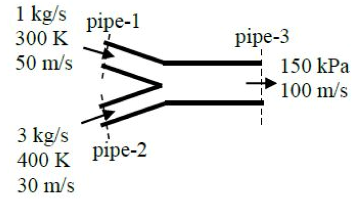
Ans: (0.026 to 0.030)
90. A 1 m3 rigid vessel contains air at 200 kPa. A vacuum pump is connected to the vessel in order to control the pressure inside. The volume flow rate of air through the pump is maintained at a constant value of 0.1 m3/s. If the pump operates for 10 seconds and the temperature of the air is maintained constant during operations, the pressure in the tank in kPa after 10 seconds (up to 2 decimal places) is ________.
Ans: (73.5 to 73.8)
91. A heat engine receives Q1 kJ of heat from a hot reservoir and rejects Q2kJ of heat to a cold reservoir. The work delivered by the heat engine is entirely supplied to a heat pump, which receives Q3kJ of heat from another reservoir and rejects Q4kJ of heat to the same cold reservoir. If the efficiency of the heat engine is 0.4 and COP of heat pump is 4.0, the value of (Q2 + Q4/Q1 (up to 1 decimal place) is ______.
Ans: (2.2 to 2.2)
92. A block of ice of mass 2 kg at 0℃ is dropped into an insulated vessel containing 10 kg of liquid water at 25℃. The latent heat of melting of ice is 330 kJ/kg and specific heat of water is 4.2 kJ/kg.K. The change in the entropy of the universe in kJ/K (up to 3 decimal places) is ______
Ans: (0.140 to 0.150)
93. A pure substance (Cv = 0.733 kJ/kg.K) undergoes a reversible process in which its temperature increases linearly from 40℃ to 85℃ and its specific entropy increases by 600 J/kg.K. The work done by the system in kJ/kg is
(A) 160.2
(B) 164.3
(C) 168.3
(D) 172.3
Ans: (C)
94. An ideal gas having a mass of 0.5 kg is initially at 300 kPa, 80℃ and occupies a volume of 0.14 m3. The gas undergoes an adiabatic process, where 50 kJ of work is transferred to the gas. The pressure and volume at the final state are 300 kPa and 0.20 m3. The change in the entropy of the gas in J/K is
(A) 160.3
(B) 175.3
(C) 190.3
(D) 195.3
Ans: (A)
95. The van der Waals equation of state is given as,
 where p in bar, v in m3/kmol and T is in K.
where p in bar, v in m3/kmol and T is in K.
For air, the constants, a and b, are 1.368 bar.(m3/kmol)2 and 0.0367 m3/kmol, respectively. Air is contained in a system at 160 K and 0.08 m3/kmol. If p1 is the pressure calculated using ideal gas equation of state and p2 is pressure calculated using van der Walls equation of state, then p1/p2 is equal to
(A) 1.78
(B) 1.52
(C) 1.28
(D) 1.0
Ans: (A)
96. The values of specific volume of H2O at 100℃ for saturated liquid and saturated vapor states are 0.001044 m3/kg and 1.673 m3/kg, respectively. The slope of saturation pressure versus temperature curve, i.e., (dp/dT)sat is 3570 Pa/K. The change in enthalpy in kJ/kg between the two saturation states is ______.
Ans: (2225 to 2230)
97. In a steam power plant, stem is first expanded isentropically in a turbine from an initial condition of 100 bar and 500℃ to a pressure of 40 bar. Then the steam is reheated up to 500℃ at constant pressure. The steam is then expanded isentropically in another turbine up to a condenser pressure 0.01 bar. For steam, at 100 bar, 500℃: h = 3373.7 kJ/kg, s = 6.5966 kJ/kg.K; at 40 bar, 500℃: h = 3445.3 kJ/kg, s = 7.0901 kJ/kg.K and at 0.01 bar: hf = 29.3 kJ/kg, hg = 2514.2 kJ/kg, sf = 0.1059 kJ/kg.K, sg = 8.9756 kJ/kg.K. The dryness fraction at the condenser inlet (up to 2 decimal places) is _________.
Ans: (0.76 to 0.82)
98. Air contains by volume 79% N2(molecular weight = 28 kg/kmol) and 21% O2(molecular weight = 32 kg/kmol)). A stream of air flows at 32℃, 1 bar, at a rate of 2 m3/s and is mixed with another stream of O2 flowing at 0.4 kg/s. The molecular weight of the mixture (up to 2 decimal places) is _____.
Ans: (29.0 to 30.0)
99. Moist air enters a duct at a rate of 3 kg/s at 10℃, 80% relative humidity. The air is heated as it flows through the duct and exits at 30℃. No moisture is added or removed and the pressure of air in the duct is constant at 1 bar. The saturation vapor pressure (pg) of H2O at 10℃ is 0.01228 bar. Specific enthalpy values of dry air at inlet and outlet of the duct are respectively 283.1 kJ/kg and 303.2 kJ/kg. The corresponding specific enthalpy values for water vapor are 2519.8 kJ/kg and 2556.3 kJ/kg. For steady state operation the amount of heat added to the moist air in kW (up to 2 decimal places) is ______.
Ans: (60.5 to 61.5)
Polymer Science and Engineering (XE-F)
100. Poly(ethylene terephthalate) is synthesized from
(A) Ethylene + dimethyl terephthalate
(B) Ethylene + terephthalic acid
(C) Glycerol + terephthalic acid
(D) Ehylene Glycol + terephthalic acid
Ans: (D)
101. Poly(vinyl chloride) has a higher Tg than polypropylene due to the presence of
(A) Bulky side groups
(B) Polar interactions
(C) Restriction of bond rotation
(D) Non-polar interactions
Ans: (B)
102. The filler which would impart electrical conductivity to a polymer is
(A) Carbon black
(B) Talc
(C) Glass beads
(D) Calcium carbonate
Ans: (A)
103. Which one of the following catalysts is used to prepare ‘isotactic’ polypropylene?
(A) Alkyl lithium
(B) BF3
(C) Ziegler-Natta
(D) AIBN
Ans: (C)
104. Novolac and resole are A-stage low molecular weight phenolic resin products that are
(A) Soluble and fusible
(B) Insoluble but fusible
(C) Insoluble and infusible
(D) Soluble and infusible
Ans: (A)
105. Which of the following reagents can act as an initiator at room temperature?
(A) AIBN
(B) Dicumyl peroxide
(C) Dibenzoyl peroxide
(D) Fe2+ + H2O2
Ans: (D)
106. The impact strength of polystyrene can be enhanced by blending/mixing with
(A) Carbon black
(B) PMMA
(C) Polybutadiene
(D) Glass fibre
Ans: (C)
107. The melt processing temperatures of a semicrystalline thermoplastic polymer is
(A) Between Tg and Tm
(B) Equal to Tm
(C) Lower than Tm
(D) Higher than Tm
Ans: (D)
108. The unit of viscosity of a polymer is expressed as
(A) Pa.s
(B) Pa.s−1
(C) Pa.s−2
(D) Pa.s−3
Ans: (A)
109. Based on the graph 1-5, which option best describes the stress-strain behavior of materials listed as P, Q, R, S and T
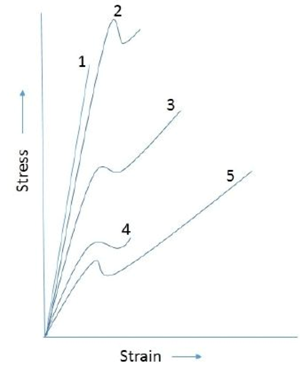
P-Hard and brittle
Q-Hard and tough
R-Soft and weak
S-Hard and strong
T-Soft and tough
(A) P-2; Q-1; R-5; S-4; T-3
(B) P-1; Q-3; R-4; S-2; T-5
(C) P-1; Q-2; R-5; S-3; T-4
(D) P-2; Q-3; R-1; S-4; T-5
Ans: (B)
110. The two characterization techniques which can be used to determine degree of crystallinity of a polymer are
P. Scanning Electron Microscopy
Q. Thermogravimetric Analysis
R. Wide Angle X-ray Diffraction
S. Differential Scanning Calorimetry
(A) P & R
(B) Q & R
(C) R & S
(D) Q & S
Ans: (C)
111. The density of polyethylene crystals is 998 kg/m3 and that of totally amorphous polyethylene is 886 kg/m3. If the density of a polyethylene sample is 949 kg/m3, the crystallinity in volume fraction is ______% (round off final answer to two digits after decimal place).
Ans: (55.95 to 56.55)
112. The polydispersity index of a polymer sample containing 200 molecules each of molecular weight 10,000 gmol−1, 300 molecules each of molecular weight 30,000 gmol−1 and 500 molecules each of molecular weight 50,000 gmol−1 is _______(round off final answer to two digits after decimal place).
Ans: (1.14 to 1.24)
113. Match the following rubber additives to their function:
Additive Function
P. Dicumyl peroxide 1. Ultrafast accelerator
Q. Pentachlorothiophenol 2. Activator
R. ZnO with stearic acid 3. Curing agent
S. Zinc diethyldithiocarbamate 4. Peptizer
(A) P-3; Q-1; R-2; S-4
(B) P-3; Q-1; R-4; S-2
(C) P-3; Q-4; R-2; S-1
(D) P-3; Q-4; R-1; S-2
Ans: (C)
114. A composite of polypropylene reinforced with 20% by volume of glass fibre is to be prepared. If the density of glass fibre is 2540 kg/m3 and polypropylene is 900 kg/m3, then the mass of glass fibre required per kg composite is ______g(round off answer to the nearest whole number).
Ans: (410 to 418)
115. Match the following terminology to the appropriate polymer processing technique:
Terminology Processing Technique
P. Die-swell 1. Two roll mill mixing
Q. Breathing 2. Thermoforming
R. Plug-assisted 3. Extrusion
S. Mastication 4. Compression moulding
(A) P-1; Q-2; R-3; S-4
(B) P-3; Q-4; R-2; S-1
(C) P-2; Q-3; R-4; S-1
(D) P-2; Q-1; R-4; S-3
Ans: (B)
116. Match the polymer in Column A to its application in Column B:
Column A Column B
P. Nylon 1. Television cabinet
Q. Polyethylene 2. Tyre
R. Cis-1, 4-polyisoprene 3. Mechanical gear
S. Acrylonitrile-butadiene-styrene 4. Packaging
(A) P-3; Q-4; R-2; S-1
(B) P-4; Q-3; R-2; S-1
(C) P-4; Q-2; R-3; S-1
(D) P-3; Q-4; R-1; S-2
Ans: (A)
117. For the polycondensation of equimolar amounts of adipic acid with hexamethylene diamine, if the number average degree of polymerization is 100, then the extent of reaction is ______%.
Ans: (98.5 to 99.5)
118. The relaxation time for a rubber band at 23℃ is 60 days. If it is stressed to 2 MPa initially, then the time required before the stress relaxes to 1 MPa is ______days (round of final answer to two digit after decimal point).
Ans: (41.00 to 42.20)
119. Match the processing technique in Column A to the corresponding shear rate (s−1) in Column B:
Column A Column B
P. Injection Moulding 1. 1-10
Q. Extrusion 2. 10-100
R. Calendering 3. 100-1000
S. Compression Moulding 4. 1000-10000
(A) P-1; Q-3; R-2; S-4
(B) P-4; Q-2; R-3; S-1
(C) P-4; Q-3; R-1; S-2
(D) P-4; Q-3; R-2; S-1
Ans: (D)
120. Given Tg of polymer A is 100℃ and that of polymer B is −100℃ , then the Tg of a miscible blend of A and B containing 30 wt% of A is _____℃(round off final answer to angle digit after decimal point).
Ans: (-67.3 to -66.3)
121. Match plots 1-4 given in the figure below with the correct flow behavior of polymeric fluid listed as P, Q, R & S:
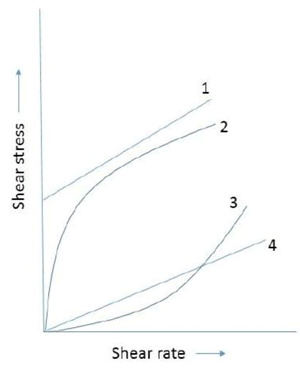
P. Newtonian
Q. Shear thickening
R. Pseudoplastic
S. Bingham plastic
(A) P-4; Q-2; R-3; S-1
(B) P-4; Q-3; R-2; S-1
(C) P-4; Q-3; R-1; S-2
(D) P-1; Q-3; R-2; S-4
Ans: (B)
Food Technology (XE-G)
122. Indicate the correct group that contains a monosaccharide, a disaccharide and a trisaccharide.
(A) Glucose, sucrose mannose
(B) Ribose, lactose, raffinose
(C) Mannose, maltose, lactose
(D) Raffinose, stachyose, glucose
Ans: (B)
123. In which of the following products, ‘must’ is used as the substrate for fermentation?
(A) Beer
(B) Wine
(C) Idli
(D) Tempeh
Ans: (B)
124. Identify the foodborne illness which is not caused by bacteria.
(A) Botulism
(B) Listeriosis
(C) Vibriosis
(D) Cysticercosis
Ans: (D)
125. Nutrient composition of wheat flour changes with extent of extraction from whole wheat grain. Which of the following statements is true if the extraction rate increased from 50% to 90%?
(A) Starch increases, protein increases, fat increases, mineral increases
(B) Starch decreases, protein increases, fat increases, mineral increases
(C) Starch decreases, protein decreases, fat increases, mineral decreases
(D) Starch decreases, protein increases, fat decreases, mineral decreases
Ans: (B)
126. You have two samples of milk, one (X) with 3.8% fat and another (Y) with 0.5% fat. In order to produce a milk with 3.5% fat, 100 ml of Y should be mixed with ____ ml of X.
Ans: (1000 to 1000)
127. Match the items in column I with the items in column II in relation to food safety and standards.
Column I Column II
P. HACCP 1.International food standards
Q. FSSAI 2. Quality control protocol
R. CIP 3. Food plant sanitation and hygiene protocol
S. CODEX 4. Indian food standards
(A) P-2, Q-4, R-3, S-1
(B) P-2, Q-3, R-2, S-1
(C) P-1, Q-4, R-2, S-3
(D) P-4, Q-2, R-3, S-1
Ans: (A)
128. A 50% sucrose solution at 20℃ is flowing at a rate of 3.5 m3/h through a pipe with an inside diameter of 0.0475 m and length of 12 m. The viscosity and the density of the solution are 15.43 cp and 1232 kg/m3, respectively. The Reynolds number of the flow is ______.
Ans: (2078 to 2086)
129. In a pineapple juice, fibre particles having mean diameter of 160 μm and density of 1075 kg/m3 are settling by gravity. If the density and viscosity of the juice are 1015 kg/m3 and 0.98 cp, respectively, terminal velocity of the fibre particles is ______mm/s.
Ans: (0.80 to 0.90)
130. Power consumption in liquid mixing is proportional to ______.
(A) Power number × liquid density × (rotational speed)3 × (impeller diameter)3
(B) Power number × liquid density × (rotational speed)2 × (impeller diameter)3
(C) Liquid density × viscosity of the liquid × (rotational speed)2 × (impeller diameter)3
(D) Acceleration due to gravity × liquid density × (rotational speed)3 × (impeller diameter)5
Ans: (A)
131. Match the following items of group I with items group II in relation to the quality of fat.
Group I Group II
P. Saponification number 1. Unsaturation of fatty acid
Q. Iodine number 2. Volatile water soluble fatty acid
R. Reichert Meissel number 3. Hydroxy fatty acid
S. Acetyl value 4. Molecular weight of fatty acid
(A) P-1, Q-2, R-3, S-4
(B) P-1, Q-3, R-4, S-2
(C) P-4, Q-1, R-2, S-3
(D) P-2, Q-1, R-3, S-4
Ans: (C)
132. Match the following metabolic product (Column I) that indicates the quality of food (Column II).
Column I Column II
P. Ethanol 1. Canned vegetable
Q. Lactic acid 2. Fish
R. Trimehylamine 3. Butter
S. Volatile fatty acid 4. Apple juice
(A) P-3, Q-2, R-34, S-1
(B) P-4, Q-1, R-2, S-3
(C) P-4, Q-3, R-2, S-1
(D) P-3, Q-4, R-2, S-1
Ans: (B)
133. Correlate the vitamins in column I with their role in promoting reaction/process in column II.
Column I Column II
P. Ribofalvin 1. Visual cycle
Q. Vitamin D 2. Acyl group transfer
R. Pantothenic acid 3. Regulation of Ca2+ metabolism
S. Vitamin A 4. Oxidation-reduction reaction
(A) P-1, Q-2, R-4, S-3
(B) P-2, Q-1, R-3, S-4
(C) P-3, Q-4, R-1, S-2
(D) P-4, Q-3, R-2, S-1
Ans: (D)
134. A pure strain with generation time of 60 min is used in a fermentation process. Following inoculation (0 h), the strain takes 2 h for adaptation, 10 h to achieve maximum growth and 12 h to arrive at the point where the death rate is higher than the growth rate. If the inoculation load is 100 cells, the total population at the end of 10 h will be ______
Ans: (25550 to 25650)
135. Refer the shear stress – shear rate plot shown in the figure below. Match the lines (Column I) with appropriate rheological behavior (Column II).
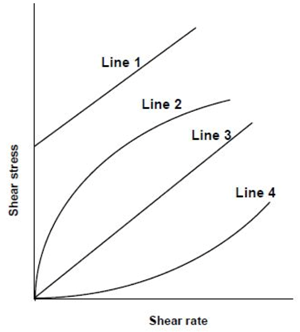
Column I Column II
P. Line 1 1. Dilatant
Q. Line 2 2. Newtonian
R. Line 3 3. Pseudoplastic
S. Line 4 4. Bingham plastic
(A) P-2, Q-3, R-4, S-1
(B) P-1, Q-3, R-4, S-2
(C) P-2, Q-4, R-3, S-1
(D) P-4, Q-3, R-2, S-1
Ans: (D)
136. Water flowing at a rate of 1 kg/min is heated from 12 to 80℃ with flue g as supplied at a rate of 3 kg/min. The temperature and specific heat of the flue gas are 180℃ and 1.05 kJ/kg.K, respectively. If specific heat of water is 4.2 kJ/kg.K and the flow is parallel, then the logarithmic mean temperature difference will be ______℃
Ans: (53.30 to 55.25)
137. The Lineweaver-Burk plot of an enzymatic reaction shows Vmax of 160 μmol/l.min and km of 60 μmol/l. For a substrate concentration of 40 μmol/l, the velocity of the reaction is estimated to be ______μmol/l.min.
Ans: (64.0 to 64.0)
138. Bread is wrapped in 0.1 mm thick cellophane film having water vapour permeability of 1.82 × 10−10 m3 water (STP)/s.m2.atm/m at 38℃. If the surface area of pack, vapour pressure of water inside and outside of the pack is 0.20 m2, 10 mm Hg and 5 mm Hg, respectively, the loss of water vapour at 38℃ in g/day is ______.
Ans: (0.14 to 0.18)
139. Match the following methods/system (column I) with the appropriate operations (column II)
Column I Column II
P. Parboiling 1. Sugarcane juice extraction
Q. Pearling 2. Hydrothermal treatment
R. Wet milling 3. Corn milling
S. Degerming 4. Wheat milling
T. Break rolls 5. Barley processing
U. Crushing rolls 6. Pulse milling
(A) P-4, Q-1, R-3, S-6, T-2, U-5
(B) P-4, Q-5, R-2, S-6, T-1, U-3
(C) P-3, Q-5, R-2, S-1, T-3, U-4
(D) P-2, Q-5, R-6, S-3, T-4, U-1
Ans: (D)
140. A 12 mm thick fish filler having 80% moisture content (wet basis) is to be frozen using a plate freezer. The plates maintained at −35℃. Assume the heat transfer coefficient, initial freezing temperature and latent heat of fusion are 2.0 W/m2 K, −2℃ and 330 kJ/kg, respectively. If the density and thermal conductivity of frozen fish filler are 1050 kg/m3 and 1.48 W/m-K, respectively, the time required to freeze the fillet from the initial freezing temperature is ______h.
Ans: (6.80 to 7.20)
141. A suspension containing 2 × 104 spores of organism A having a D1℃ value of 1.5 min and 8 × 105 spores organism B having a D121.1℃ value of 0.8 min is heated at a constant temperature of 121.1℃. The heating time needed to obtain a probability of spoilage ‘1 in 1000’ is ____min.
Ans: (10.80 to 11.20)
142. In an evaporation process, a compressor picks up 0.05 m3 air in each revolution and compresses 500 kg of air per minute. If the specific volume of air is 0.9 m3/kg, then the compressor speed is _____ rpm.
Ans: (9000 to 9000)
143. For a soybean oil extraction system, solvent : soy ratio is maintained at 0.5 : 1 (w/w). Original seed contains 18% oil (w/w). If the meal (soy solid) after final desolventization has 0.01 kg oil per kg oil free meal then, the effectiveness of the solvent (kg oil/kg solvent) in the extraction process is _____
Ans: (0.30 to 0.40)
Atmospheric and Oceanic Sciences (XE-H)
144. Rossby Number is the ratio of
(A) Coriolis Force to Inertial Force
(B) Inertial Force to Coriolis Force
(C) Gravitational Force to Coriolis Force
(D) Viscous Force to inertial Force
Ans: (B)
145. Kuroshio Current and Gulf Stream are
[WBC : Western Boundary Current, EBC : Eastern Boundary Current]
(A) EBC, WBC
(B) EBC, EBC
(C) WBC, WBC
(D) WBC, EBC
Ans: (C)
146. The velocity of a tsunami wave in an ocean basin of depth 1 km is _____ ms−1
[Density of seawater : 1025 kg m−3, g: 10 ms−2]
Ans: (98.9 to 100.5)
147. A thin iceberg is observed to move southeastward in the Arctic Ocean. If the surface current is wind driven, the prevailing wind is
(A) Easterly
(B) Northerly
(C) Southerly
(D) Westerly
Ans: (D)
148. Equatorial Kelvin and Rossby waves respectively propagate
(A) Westward and Eastward
(B) Eastward and Westward
(C) Westward and Westward
(D) Eastward and Eastward
Ans: (B)
149. The largest contributor to the atmospheric greenhouse effect is
(A) CO2
(B) N2
(C) CH4
(D) H2O
Ans: (D)
150. If Tv, T, Tw and Td denote virtual, dry bulb, wet bulb and dew point temperatures of a moist air parcel, then the correct order of their values is
(A) Tv > T > Tw > Td
(B) Tv ≥ T ≥ Tw ≥ Td
(C) Tv > T ≥ Tw ≥ Td
(D) T > Tv > Tw > Td
Ans: (C)
151. Burning of fossil fuel is increasing the concentration of CO2 in the atmosphere. A consequence of this is
(A) Ocean water which is presently basic will drift toward pH neutral
(B) Ocean water which is presently acidic will become more acidic
(C) No effect on ocean pH
(D) Ocean water which is presently slightly basic will become more basic
Ans: (A)
152. Mixed layer depths measured in the Pacific Ocean in two different years are schematically shown in the figure below.
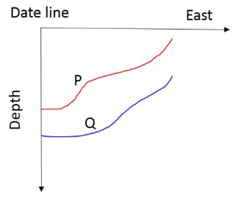
Years P and Q belong to
(A) P: El-Nino, Q: La-Nina
(B) P: La-Nina, Q:El-Nino
(C) P: El-Nino, Q:QBO
(D) P: QBO, Q: La-Nina
Ans: (B)
153. Average surface temperatures of the Sun and the Earth are 6300 K and 285 K, respectively. The ratio of the wavelength of peak radiation of the Earth to that of the Sun is _______.
Ans: (22.05 to 22.15)
154. In the month of April, the mixed layer in the Arabian Sea received a net heat flux of 50 W m−2. If the mixed layer depth is 50 m, the increase in temperature at the end of April is ______℃
[Density of seawater: 1025 kg m−3, Density of freshwater : 1000 kg m−3, Specific heat of seawater: 4200 J kg−1 K−1, Latent heat of evaporation: 2.45 × 106 J kg−1]
Ans: (0.59 to 0.61)
155. The thickness of an atmospheric layer between 600 hPa and 500 hPa is 1.5 km. If the layer is isothermal, then its temperature is _____K.
[Gas constant of air: 287 J kg−1 K−1, g : 10 ms−2]
Ans: (286.55 to 287.55)
156. At 17°N, a mass of fluid moving under geostrophic balance at 0.3 ms−1 towards east. Suddenly the pressure gradient force becomes zero. Then the fluid will
(A) continue to move towards the east at 0.3 ms−1
(B) undergo circular motion with radius of about 17 km
(C) undergo circular motion with radius of about 7 km
(D) move southward
[Angular velocity of the Earth: 7.27 × 10−5 rad s−1]
Ans: (C)
157. At 45°N, wind is blowing northward and its magnitude decreases eastward from 10 ms−1 to 1 ms−1 over a distance of 18 km. The absolute vorticity of the flow is ________× 10−4 s−1
(Angular velocity of the Earth: 7.27 × 10−5 rad s−1]
Ans: (-4.10 to -3.90)
158. Sea surface height anomalies at the locations A, B, C and D are −10, −15, 5 and 0 cm respectively.
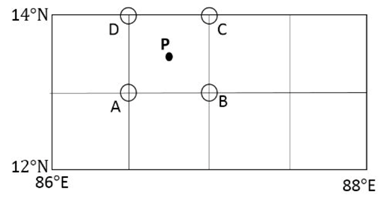
The magnitude of geostrophic velocity at P is _____ms−1.
[Take 1° = 100 km, g = 10 ms−2, Angular velocity of the Earth: 7.27 × 10−5 rad s−1]
Ans: (0.42 to 0.46)
159. In a severe tropical cyclone, 250 m of rainfall occurs in an area having a radius of 200 km. If the energy supplied to the system from this rainfall is N times the energy of one atomic bomb (=1.5 × 1015 kJ), then the value of N is _______.
[Density of freshwater: 1000 kg m−3, Specific heat of seawater: 4200 J kg−1 K−1, Latent heat of evaporation: 2.45 × 106 J kg−1]
Ans: (51 to 52)
160. A student wants to numerically solve the linear 1-D advection equation  where c = 300 ms−1. The value of the maximum time-step the student can consider according to CFL criterion for a spatial resolution of 3 km is
where c = 300 ms−1. The value of the maximum time-step the student can consider according to CFL criterion for a spatial resolution of 3 km is
(A) 15 s
(B) 10 s
(C) 25 s
(D) 20 s
Ans: (B)
161. Planets in the solar system are in radiative equilibrium. Let S0, α, T0 and R denote solar constant, albedo, average temperature and radius of a planet, respectively, and σ is Stefan’s constant. Then the energy balance of this planet is given by the expression
(A) ![]()
(B) ![]()
(C) ![]()
(D) ![]()
Ans: (A)
162. A cumulonimbus cloud forms by an air parcel rising from the sea level with an initial temperature and specific humidity of 27℃ and 20 gm kg−1, respectively. Assume that moist static energy is conserved in this cloud. Then the cloud temperature at an altitude of 15 km is ______K.
[Specific heat of dry air at constant pressure: 1005 J kg−1 K−1, Specific heat of water vapour at constant pressure: 1850 J kg−1 K−1, g = 10 ms−2, Latent heat of evaporation 2.45 × 106 J kg−1]
Ans: (199 to 205)
163. If ug and vg are respectively zonal and meridional components of a flow field in geostrophic balance, then the divergence of this flow is
(A) ![]()
(B) ![]()
(C) 
(D) 
Ans: (D)
164. During the Indian summer monsoon season, depressions do not intensify to tropical cyclones because
P: Indian sub-continent is very hot and large land-sea temperature difference pulls depressions quickly to land before they can intensify into cyclones.
Q: southwesterly winds at low level are not conductive for the formation of tropical cyclones.
R: SST cooling due to strong monsoonal winds prevents cyclone formation.
S: strong zonal wind shear during the monsoon season does not allow warm core formation.
Which of the above statement(s) is(are) correct
(A) P & Q
(B) only R
(C) Only S
(D) R & S
Ans: (C)
165. Which among the following statement(s) is (are) correct,
P: ENSO and El-Nino are the same refer to the warming of Equatorial Eastern Pacific SST.
Q: ENSO is an atmosphere-ocean coupled phenomenon and El-Nino is its oceanic part.
R: ENSO is an atmospheric phenomenon and El-Nino is an oceanic phenomenon
S: ENSO is the oscialltory component of El-Nino having a period of 4.7 years.
(A) P & R
(B) Only Q
(C) P, Q and S
(D) R & S
Ans: (B)
General Aptitude
166. The event would have been successful if you ______ able to come.
(A) are
(B) had been
(C) have been
(D) would have been
Ans: (B)
167. There was no doubt that their work was thorough.
Which of the words below is closest in meaning to the underlined word above?
(A) Pretty
(B) Complete
(C) Sloppy
(D) Haphazard
Ans: (B)
168. Four cards lie on a table. Each card has a number printed on one side and a colour on the other. The faces visible on the cards are 2, 3, red, and blue.
Proposition: If a card has an even value on one side, then its opposite face is red.
The cards which MUST be turned over to verify the above proposition are
(A) 2, Red
(B) 2, 3, Red
(C) 2, blue
(D) 2, red, blue
Ans: (C)
169. What is the value of x when 
(A) 1
(B) −1
(C) −2
(D) Cannot be determined
Ans: (B)
170. Two dice are thrown simultaneously. The probability that the product of the numbers appearing on the top faces of the dice is a perfect square is
(A) 1/9
(B) 2/9
(C) 1/3
(D) 4/9
Ans: (B)
171. Bhaichung was observing the pattern of people entering and leaving a car service centre. There was a single window where customers were being served. He saw that people inevitably came out of the centre in the order that they went in. However, the time they spent inside seemed to vary a lot: some people came out in a matter of minutes while for others it took much longer.
From this, what can one conclude?
(A) The centre operates on a first-come-first-served basis but with variable service times, depending on specific customer needs.
(B) Customers were served in an arbitrary order since they took varying amounts of time for service completion in the centre.
(C) Since some people came out within a few minutes of entering the centre. The system is likely to operate on a last-come-first-served basis.
(D) Entering the centre early ensured that one would have shorter service times and most people attempted to do this.
Ans: (A)
172. A map shows the elevations of Darjeeling, Gangtok, Kalimpong, pelling, and Siliguri, Kalimpong is at a lower elevation than Gangtok. Pelling is at a lower elevation than Gangtok. Pelling is at a higher elevation that siliguri. Darjeeling is at a higher elevation than Gangtok.
Which of the following statements can be inferred from the paragraph above?
i. Pelling is at a higher elevation than Kalimpong
ii. Kalimpong is at a lower elevation than Darjeeling
iii. Kalimpong is at a higher elevation than siliguri
iv. Siliguri is at a lower elevation than Gangtok
(A) Only ii
(B) Only ii and iii
(C) Only ii and iv
(D) Only iii and iv
Ans: (C)
173. P,Q,R,S,T and U are seated around a circular table. R is seated two places to the right of Q.P is seated three places to the left of R. S is seated opposite U. If P and U now switch seats.
Which of the following must necessarily be true?
(A) P is immediately to the right of R
(B) T is immediately to the left of P
(C) T is immediately to the left of P or P is immediately to the right of Q
(D) U is immediately to the right of R or P is immediately to the left of T
Ans: (C)
174. Budhan covers a distance of f19 km in 2 hours by cycling one fourth of the time and walking the rest. The next day he cycles (at the same speed as before) for half the time and walks the rest (at the same speed as before) and covers 26 km in 2 hours. The speed in km/h at which Budhan walks is
(A) 1
(B) 4
(C) 5
(D) 6
Ans: (D)
175. The points in the graph below represent the halts of a lift for duration of 1 minute, over a period of 1 hour.
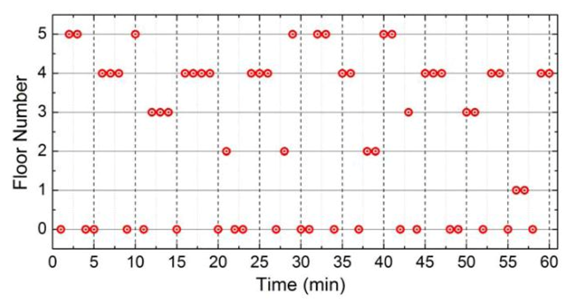
Which of the following statements are correct?
i. The elevator never moves directly from any non-ground floor to another non-ground floor over the one hour period
ii. The elevator stays on the fourth floor for the longest duration over the one hour period
(A) Only i
(B) Only ii
(C) Both i and ii
(D) Neither i nor ii
Ans: (D)
Latest Govt Job & Exam Updates: